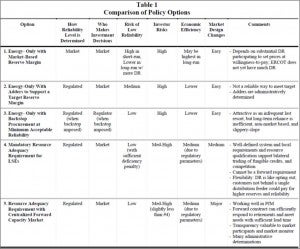This Friday, the Public Utility Commission (PUC) will host a workshop to discuss the Brattle Group’s recommendations for Texas’ resource adequacy predicament and how to move towards sustained reliability. This workshop is timely, since the Texas energy crunch continues to be in the spotlight. Just last week, the New York Times reported that Texas ranks last in electrical reliability among all states in the U.S. Texas won’t stay open for business if that remains the case and year after year it seems our state energy policy is based on a hope and a prayer.
Table 1 of the Brattle report outlines the five policy options to solve the long-term problems.
The report specifically states that “reliance on scarcity prices is unlikely to achieve current reliability objectives.” Therefore raising the price cap is, alone, not going to solve the problem. As mentioned at the Senate Business & Commerce committee earlier this month, this issue was plagued by accusations that the market was being manipulated because of violent price fluctuations on June 25 and 26. It turns out the market is not being manipulated, which is good, but that it is really just dysfunctional in design, which is not so good. Colin Meehan’s blog last week highlights this issue and makes the point that while the PUC is willing to potentially pass the costs of a price cap increase onto ratepayers, it should also consider demand-side resources suggested by Brattle which could positively affect ratepayers. For example, in the PJM market demand-side resources are allowed to participate in energy and capacity markets and over $20 million of the payments went to residential customers.
EDF submitted comments for this workshop and will be in attendance. Other public comments were made from a variety of stakeholder’s including demand response advocacy groups, cities, MOUs, and power companies.
EDF believes that “such reforms must include a substantially increased role for demand response (DR) and other demand-side resources in ERCOT’s markets; the report provides ample supporting evidence for this need. EDF requests detail on the level of DR needed to maintain reliability in each scenario [in chart above], what would be required in each scenario to attain those levels, as well as the role of other demand-side resources in meeting future resource needs.”










